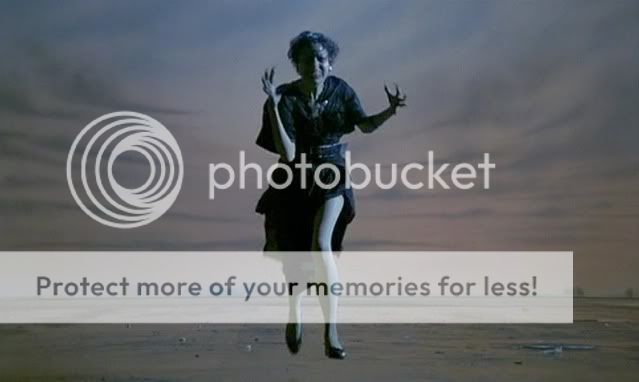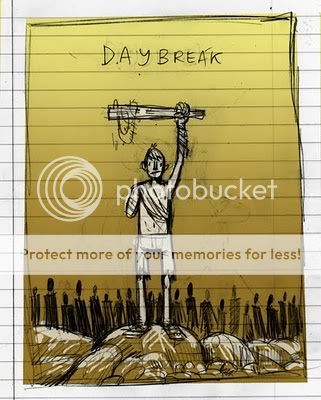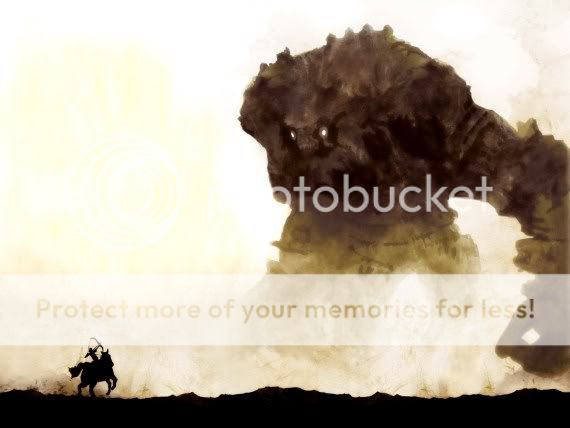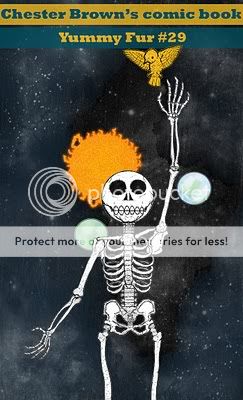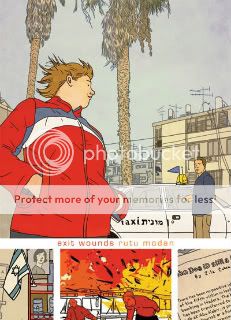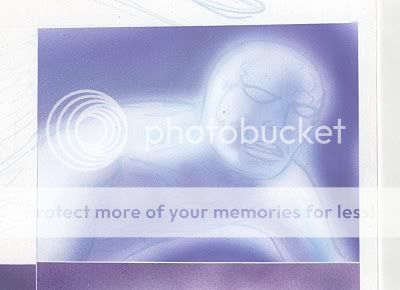In college, some friends introduced me, under circumstances you can probably imagine, to the concept of “the Cosmic Groove”–the funk into which all bands seek to tap, but which aside from a few fleeing moments remains elusive. It wasn’t until I heard Phelps “Catfish” Collins’s guitar solo on “Very Yes” with Bootsy’s Rubber Band live in Lousiville 1978 that I understood what they meant. That guitar is like the Ghostbusters crossing the streams, and when the horns come back in, that’s the dimensional crossrip. This is the sound of the cosmic groove–it’s like My Bloody Valentine’s “Soon” in that I’ve wanted so badly to find another song that does what this does as well as it does it but have never found it and probably never will. Rest in peace, Catfish.
Comics Time: The Witness
The Witness
Hob, writer/artist
self-published, 2008
24 pages
$3
Comics about death, even good comics about death, are a dime a dozen.. Comics about death where the character that dies is biologically incapable of understanding what has happened to it? And in which the entire world dies, completely and irrevocably, taking all hope of future life with it? Rarer, and thank goodness, because I don’t know how many comics like this one I could take without cracking. This is not to say that the artist otherwise known as Eli Bishop’s “ghost story” about a dinosaur whose spirit lingers on Earth, occasionally interacting with its inhabitants (both alive and dead) until the solar system’s destruction billions of years from now by the expanding sun, is morbid or grim beyond the needs of the subject. Something about his airy, elegant line–able to convey the weightlessness of the dino-ghost and to accrue background detail without bogging the image down–prevents The Witness from ever feeling dreary or didactic. But that’s just it: This casual acceptance of the death of all things, a post-life eternity that just spirals on and on and on and on and on and on without ending, ended up being much more chilling to me than most stories about shuffling off this mortal coil. I’ve thought about my eventual expiration enough that doing so is like meeting a familiar friend. But death without the possibility of thought, by you, by anyone or anything else? That’s a stranger at the door and I’m afraid to let him in.
Carnival of souls
* Dunno how the heck I missed this, but Mike Mignola will be drawing Hellboy again following the conclusion of the current six-part-total arc with Duncan Fegredo.
* Ben Jones has a blog at PictureBox’s site now? When did this happen? (Via Flog.)
* Good golly Miss Molly, look at this drawing of Galactus by James Stokoe. Click here to make it bigger than your brain can handle.

* Gabrielle Bell is now on Jordan Crane’s webcomics site What Things Do, with maybe the first of her strips I feel like I’ve “gotten.”
* Real Life Horror: Here’s a fascinating, if scantly supported, article on the prevalence of serial killers in Africa, enabled by the combination of weak law enforcement and ritual traditions that countenance violence. (Via CRwM.)
Music Time: Wild Beasts – Two Dancers
Wild Beasts
Two Dancers
Domino, September 2009
Co-lead singers Hayden Thorpe and Tom Fleming represent the meticulously struck balance of Wild Beasts’ second album of sumptuous, occasionally shocking art-rock Two Dancers as well as anything else. Like Bryan Ferry subjected to some sort of Silver Age DC Comics bifurcation beam, Thorpe sings in a foppish falsetto, Fleming in a rich mahogany baritone. Each vocal approach enhances different aspects of the band’s music: Thorpe’s swoops and screeches twirl effortlessly atop and around the keening guitar of Ben Little, while Fleming’s warmth and fullness echoes the rock-solid foundation laid down by his basslines and Chris Talbot’s surefooted drumming.
Yet at the same time, each undercuts and complicates the lyrics they sing, lyrics that treat male desire and anger with often alarming openness. Thorpe can deliver kiss-offs to a former lover like “This is a booty call–my boot up your asshole” (“The Fun Powder Plot”) or proclaim his penchant for hooliganism by announcing “We’re just brutes, looking for shops to loot” (“Hooting & Howling”) and get away with it, his dandyish, defiantly artificial voice stripping the words of tough-guy posturing and exposing the awkwardly animalistic sentiments beneath. For his part, Fleming can flat-out sing about his id, as he does in “All the King’s Men”–“Baby, turns out I’m evil / In all my dreams, girls who’ll clothe me, girls who’ll feed me, girls who want me, girls who need me”–but the Guinness-like depth and complexity of his tone conveys far more self-awareness and self-effacement than self-congratulation. The lyrics’ repeated references to the body parts involved in sundry acts of rage and lust and gluttony further emphasize the degree to which these men, for all their erudition, are at the mercy of meatspace. I count fully 46 mentions of everything from bones and teeth to hearts and lungs to ankles and assholes in the lyric sheet; tellingly, the eyes, the window to the soul, are only mentioned once.
Given this, it’s no surprise that the group assigns the album’s sexiest song–the churning “When I’m Sleepy…,” its lyrics consisting solely of the phrase “When I’m sleepy, needing supper, you’re the lips for me to pucker”–to the more feminine vocalist, while the baritone is responsible for the harrowing semi-title track “Two Dancers (i)” and its seemingly and sympathetically feminine perspective on sexual assault and the death of and abandonment by children. Simply the phrases selected to convey these ideas–“His hairy hands, his falling fists, his dancing cock down by his knees”; “Our son was dying and we could hardly eat”–form a devastating j’accuse when issued from the bass clef.
The music seems similarly obsessed with the possibilities of duality represented by both singers and album title. The title track is split in two, for one thing, with “Two Dancers (ii)” representing a quieter, colder response to the fiery demands of its immediate predecessor; the pair is itself prefigured by the introduction of its central melodic hook at the very end of “Hooting & Howling” several songs earlier. The album features two short interlude-type songs: The first is the aforementioned sizzler “When I’m Sleepy…”, while the second, the far quieter “Underbelly,” is as much about lifelong consequences for the seven deadlies as the earlier song is about their immediate gratification. But my favorite pairing is the opening track, “The Fun Powder Plot,” with the late-album centerpiece “This Is Our Lot.” To take things back to the Silver Age, they’re each the Bizarro version of the other. With the same gently twirling mechanical beat and even the same key, “This Is Our Lot” inverts the earlier song, allowing the bass to provide the melody and the guitar to provide the rhythm–a switch paralleled by Thorpe, who here sings toward the bottom of his register. The overall shift is one from hysterical outrage to wry resignation, “The mock” and “the shock” of “The Fun Powder Plot” replaced by the shrugged-shoulder admission “This is our lot: We hold each other up heavy with hops.”
The end result? Masculinity without machismo. Sexuality without sexism. Elegance without arrogance. Wild Beasts set a very tricky lyrical and stylistic course for themselves here, but their rare combination of ambition and sophistication sees them arrive not just safely but spectacularly.
A request
I would like to move my blog to a new, dedicated site. I need someone to help me do this–namely to design the new site and port my Movable Type archives into it. I have some other more ambitious wishlist items too, but those are the main things. I will pay this hypothetical person for doing this. Are you this person? Please email me (the address is in the left-hand sidebar of this blog) and let me know.
Carnival of souls
* Your quote of the day comes from Tom Spurgeon:
Mostly, though, I’m kind of baffled why retailers meet anything I write that’s critical of any facet of the Direct Market with such forceful, blanket and frankly not always very convincing rebuttals….what’s up with the defensive crouch? How on earth is a critical article tantamount to taking a position of “all doom and gloom?” Do you have a self-critical apparatus? Is ComicsPRO simply a booster organization that does things like impugn others’ motives and make empty proclamations that things are “rock solid”? If asked, could you name five specific areas at which the Direct Market should improve, things at which you and your fellow retailers have outright failed, not somebody else? I could do that for this site specifically and comics journalism generally, and have talked about those factors here at the site on multiple occasions. Why can’t you guys? It’s one thing that outright confuses me about comics 16 years in, retail and elsewhere. What is it about comics people that we’re afraid to release real sales or (when it’s appropriate) income figures, where publishing moves that seem to under-perform disastrously by the estimates we do have are met with a “that’s right what we expected/you don’t know anything about the business” harangues, where it’s the comics event itself that conspires to keep the journalists from covering it with greater vigor? Why can’t we be self-critical?
Read the whole thing, including the jaw-dropping letter to which he’s responding.
* Mike Baehr notes in the comments downblog and on the Fantagraphics blog that Fanta/Eros isn’t republishing Hans Rickheit’s Chloe, just distributing it to the Direct Market for, amazingly, the first time. Really can’t say enough good things about that book, though I’ve got a funny feeling I’ll be trying to over the next week or so.
* Jeet Heer’s piece on Harvey Pekar for Comics Comics contains a pretty egregious misreading of the Lee/Kirby working relationship, of all things, but is well worth your time anyway for its emphasis on the salutary impact Pekar had on Crumb rather than the other way around, and how Pekar’s preference for realistic writing may have skewed his taste in artists in an unfortunate way.
* Somehow the RSS feed for Sammy Harkham’s Family store blog disappeared from my Google Reader or something, but thanks to Spurge I’m tuned back in in time to catch Sammy’s salute to Richard McGuire, perhaps the only person of whom it can be said that they created one of the greatest comics and greatest basslines of all time.
* Harkham also posted some more pics of the ice cream truck Ben Jones designed for Adult Swim’s San Diego presence. Would you let your kids get a froggy pop from this truck?
* John Lingan’s piece on Christian Nyby/Howard Hawks’s The Thing from Another World and John Carpenter’s remake The Thing is odd in that it posits a world in which the former has the better critical reputation, a world I’m pretty sure the rest of us don’t live in, but hey, I’m always up to read about The Thing. Nice analysis of the purpose of the spectacular gore, for example.
* Frank Santoro sez don’t forget that your comics page needs a center. This came up in his Inkstuds roundtable from the other day as well. I’m still processing it.
* Filing this away for future reference: Chris Mautner reviews Scott Pilgrim vs. the World.
* Speaking of Scott Pilgrim, here’s a fun, frivolous report on an in-store appearance by Edgar Wright, Michael Cera, Anna Kendrick, and Jason Schwartzman by my chum Jason Adams.
* And speaking of Jason, he says that this is what Lamberto Bava’s Demons 2 looks like, which probably means I need to see Lamberto Bava’s Demons 2.
* Clive Barker Halloween costumes! Yep, that’s about right. How I love this raspy-voiced loon. (Via Monster Brains.)
* Real Life Horror: The Journal of American Medicine on the damage done by CIA doctors and psychiatrists who tortured people for the Bush Administration.
* So epic. When my teenage self first saw this image, a rip in the spacetime continuum opened up and John Williams’s “Duel of the Fates” started playing.
Comics Time: Prison Pit: Book 2
Prison Pit: Book 2
Johnny Ryan, writer/artist
Fantagraphics, July 2010
116 pages
$12.99
“OPERATION: RAPE LADYDACTYL. BEGIN.”
It wasn’t until I read those words on the screen of a computer operated by a robotic antagonist of Prison Pit‘s main character Cannibal Fuckface that I realized just how far Johnny Ryan was going to go with this series. Obviously it was already beyond violent; obviously it was already beyond sexually vulgar as well, what with Volume One’s maggot-fellatio fade-out. Obviously Volume Two was already filled to bursting with literally nauseating body-horror transformations and mutilations brought to life (and death) by Ryan’s never better, never nastier pen art. But an extended sequence in which our anti-hero is forced against his will to hunt down, attack, maim, and graphically rape-murder a creature that’s distinctly female even for all its monstrousness, one that screams in agony…for the first time I realized that Prison Pit isn’t a fusion-comics exploration of awesomeness in all its forms, but a horror-comics exploration of awfulness–of violence that maims and kills not just body but soul. Ryan is willing, even this early in a series I imagine will be able to last as long as he wants it to, to completely invert his instantly-iconic warrior, to make the audience root against him desperately, to feel dick-shriveling revulsion at his violence and pity for his victim. “That fucking sucked,” CF says when it’s all over. Understatement of the year. This book is a masterpiece of awfulness.
Carnival of souls
* Big new books from Ben Katchor and Daniel Clowes on the way from Pantheon next spring. The Cardboard Valise is Katchor’s first book in ten years plus, while Clowes’s Mister Wonderful will apparently include 40 new pages.
* Whoa, Fantagraphics is rereleasing Hans Rickheit’s Xeric-winning graphic novel Chloe through its Eros imprint? I wish it were being done by Fanta proper–the fact that it isn’t explains why I didn’t know about it until today–but even still, run, don’t walk, to get that book. Rickheit’s a major talent and that book is something erotic and special. It’s like a dirty secret.
* Spectacularly talented alternative cartoonists: They’re just like us! Kevin Huizenga rents random popular comedies and genre movies from the library!
* I’m glad this worked out for all concerned, but still, threatening a licensed publisher of a franchise over infringing the copyright of your fan-film based on that franchise? How would that work, exactly?
* Alyssa Rosenberg considers A Song of Ice and Fire, Harry Potter, The Lord of the Rings, world-building, and emotional wiggle room.
* These Brian Ralph sketches sure look like Daybreak collected-edition cover mock-ups to me…
* The Rocky Horror Picture Show on Blu-Ray. Don’t know why that never occurred to me before.
* Nor had it ever occurred to me to look for the Predator soundtrack album, which apparently is only now coming into existence.
* Tom Ewing is right: that new Arcade Fire song is not hot. Personally, I tuned out when they rhymed “sprawl” with “shopping malls,” like a Bad Religion album cut. I wouldn’t go quite as far as Mike Barthel because I think it’s perfectly legitimate to remain aghast at a lot of what goes on in suburbia even as an adult; I just think it’s bloated, boring music and trite lyrics delivered with irritating vocals, which is what I’ve always thought of the Arcade Fire.
* Real Life Horror: When I, a proven fool or worse on such matters, talk about politics on this blog these days, it’s usually in the horror-tinged context of torture or the action/sci-fi framework of a militarized Republican party. But of course these two phenomena are not unrelated. And now we can perhaps add a third category, as articulated by Jim Henley: the degree to which the ugly bigoted sentiments of a swathe of the American right are now being made manifest as actual discriminatory policy, from already nationwide attempts to thwart the construction of mosques anywhere for any reason, to attempts to revise or reinterpret (or repeal?) the 14th Amendment so as to deny birthright citizenship to so-called “anchor babies” on the basis of no one knows what exactly. To a degree, we’re all the blind men feeling the elephant when it comes to the darker forces at work in American political life today. Well, here we have a movement that supports the government’s ability to imprison and torture its perceived enemies at will; that makes a habit of arming itself and discusses this as a potential way to redress its grievances with its political and governmental opposition; and which seeks to abrogate basic constitutional rights for minority ethnic and religious groups deemed insufficiently American. What does that elephant look like to you?
Music Time: Spoon – “Who Makes Your Money”
Spoon
“Who Makes Your Money”
from Transference
Merge, January 2010
Restraint can be so sexy! Listen to the minimalist groove of this song: It’s mostly a tight pencil sketch of a drumbeat and a three-note keyboard hook that sounds like fingertips just barely grazing the keys. The bass comes in not much more often than every other measure, just enough to keep the low end a presence in your mind. There’s a rhythm-guitar…undercurrent, is the best word for it. Every once in a while there’s a little textural sizzle that fades in and out. Even the vocals are deployed with the minimal sufficient force: The titular refrain is so underpronounced that I spent my first listen to the song thinking it was called “Who Makes You Mine.” And perhaps with that in mind I thought this was a song about dark, possessive sexuality–a misconception that did not change one iota when I found out the real title, by the way. It was only when I made a point of seeking out the lyrics that I discovered it’s actually a song about being a slave to the wage, not a slave to love. But with an arrangement this exquisitely perched on the precipice between sensuous and ominous, it works either way.
Carnival of souls
* I interviewed Grant Morrison and Adam Egypt Mortimer about their upcoming film Sinatoro for Comic Book Resources. Because it’s so early in the game they are in large part limited to enthusiasm and hyperbole, but they’re pretty self-aware about that. I liked this bit:
We wanted to do something that took the language of movies and brings it into the 21st century. One of the things I was saying over the weekend was this idea that most of us have been playing video games and grew up watching MTV and music videos. The art that we’ve absorbed has changed. The way we look at things and the way we tell stories is a little bit different than how it used to be. I like the idea of introducing that back into the basic Hollywood narrative. Taking some of that, and all the building blocks we’re familiar with – the boy-meets-girl, the revenge story, the thriller, the murder mystery, the crime story – and combine all that together. It”s a little like what I did with Batman and Superman: take all the things we love about cinema and then put them together again in a slightly new way which still fulfills all the [original] functions. It still makes you laugh and cry and sing and dance.
* Clive Barker says Volume III of his Abarat young-adult fantasy series will come out in September 2011. Given that what would have been the ending in most YA fantasy series took place at the end of Volume 2, I suppose it’s no shock it’s taking this long to ramp up to the next installment.
* Since I am increasingly pessimistic about the economy in general and the long-term structural changes being made that will adversely effect the creation of art in particular, I’m always game for discussions Tom Spurgeon’s thoughts on the future of comics retail in a piece on five comics news stories to watch:
It’s take your pick of portents: the absence of a vital retailer selling new comics at Comic-Con the way Comic Relief used to underlines the notion that owner of the majority of comics’ best shops are getting older, there’s never a guarantee that these businesses change hands without causing major differences in what they’re able to do, and I’m not sure there are enough up and coming retailers to play the same role as the generation of retailers now in that 55 and over club. Price increases, continued horrific scheduling strategies, a ridiculous and inflexible start-up model, over-publishing and the slight discombobulation that is likely to arrive with an upswing in attention to digital comics strategies are making things more difficult for the system just at the time when everything should be done to make things easier. As second downswing in the economy will likely drive lot of folks to reconsider what they do, and comics seems less likely to escape a second generally fallow period coming so quickly on the heels of the first.
* I am enjoying Robin McConnell’s Inkstuds roundtable on “fusion comics,” aka the New Action plus some other mixed-genre/style stuff, with Frank Santoro, Brandon Graham, and Michael DeForge as we speak. Here are Frank’s notes for the interview. Obviously a lot of this material excites me as well, and I love all these artists bringing non-traditional influences to the table. It makes for exciting art, and exciting discussions between artists. As for criticism…Honestly? I do worry a bit, from a look around the blogosphere on any given day, that rise of fusion/New Action gives people the critical cover they’ve long secretly craved to talk only about genre, to the exclusion of non-genre work. (I oughta know!) Oh, I dunno, I’m a scold these days. Maybe it’s just that I’ve always proceeded from the notion that this stuff is legit to talk about, and so it doesn’t fire me up, like, eight years into talking about comics professionally and semiprofessionally. I’ve got my own issues, like.
* CRwM waxes eloquent on John McTiernan’s Predator and Die Hard, two films that undercut the Action Hero, examining the varying degrees to which they do so. Check the comments for TroyZ’s take on the matter as well.
* The Ten Video Games Roger Ebert Should Play. I’ve never been heavily invested in what Ebert thinks and this has not changed with his recent renaissance, but a) It’d be interesting if the collective Green Lantern power of the Internet wills him into liking video games after a prolonged period of philistinism, and b) this list doubles well as a Ten Video Games Sean T. Collins Should Play list.
* I’d forgotten how good the cover for Chester Brown’s Yummy Fur #29 was; Ruaraidh Bruce reminds us with a cover version at Covered.
* I love Rickey Purdin “What I Got at [Comic Convention X]” posts, because Rickey Purdin loves getting comics.
* I briefly want to draw your attention to a couple of other Internet ventures for which I am responsible: Fuck Yeah, T-Shirts, consisting of cool pictures of people wearing t-shirts;
* and Bowie Loves Beyonce, consisting of cool pictures of David Bowie and Beyonce.
* It’s been a while, for medical reasons, but I would like Serge Gainsbourg’s “Cannabis” (via Nate Patrin) to provide the soundtrack for all my future usages of the titular substance. I suspect it would be impossible not to feel like a cool dude with all the right moves under such circumstances.
* An LCD Soundsystem/Hot Chip/Sleigh Bells tour? Oh, indeed.
Comics Time: Exit Wounds
Exit Wounds
Rutu Modan, writer/artist
Drawn & Quarterly, 2007
168 pages
$16.95
What a lovely-looking book Exit Wounds is. Rutu Modan’s skillful take on the Clear Line style elicits strong “performances” from her characters, creates an inviting depth of field, and holds her frequently sumptuous colors quite well. Her staging is rarely as dynamic as that cover image, but when it is, hoo boy, fabulous stuff. Overall I feel like she’s doing with the Clear Line what Emmanuel Guibert tried but failed to do in an inkier style: Take real life and gradually subtract detail until what remains is paradoxically even livelier.
The story? Eh. It’s your basic alternative-comics “young person’s personal epiphany enabled by unexpected, brief, intense, difficult relationship with other young person” story, a template established by the likes of I Never Liked You, Black Hole, and Ghost World, gone supernova with Blankets, and since utilized to varying degrees of success by Adrian Tomine, Danica Novgorodoff, Blaise Larmee, Paul Hornschemeier, Dash Shaw, Hope Larson, Bryan Lee O’Malley, the Tamaki sisters cousins, Natsume Ono, Inio Asano, and so on and so forth. This particular variation is uninspired and, literally, unsurprising. When their personalities clashed; when they fell into an uneasy rapport that slowly grew into an easy one; when they argued and made up; when they staved off emotional disaster by having ill-advised sex; when they stormily split up; when they capped off the book with a highly symbolic interpersonal act–each of these elicited a “yep, that’s pretty much what I expected” from me.
The affair is sprinkled with light commentary about Israel’s social, economic, ethnic, and denominational stratification. It’s subtle, thoughtful stuff, focusing on the way that both the state’s inherent construction and its predicament vis a vis its neighbors and occupation-ees constantly juts into people’s personal lives in mostly quiet, mostly unpleasant ways. That and the sumptuous art is probably what got the book over with so many readers and critics. But to me, it’s a little like getting a molten chocolate cake with no molten chocolate inside. It’s not quite a hollow experience, like one of those chocolate Easter bunnies where it’s just a thin layer of yummy and then a lot of air–the cake is substantial and sweet. But without the molten chocolate that a less predictable, more alive story would provide, you still feel like something’s missing.
Music Time: 80 Great Tracks from the 1990s That Aren’t on Pitchfork’s Top 200 Tracks of the 1990s List
BACKDATED FOR EASE OF BROWSING
I enjoyed Pitchfork’s list of the Top 200 Tracks of the 1990s. The decision to limit the list to one song per artist opened things up to tons of songs, probably even whole genres, that would have been excluded if folks like Bjork and Beck and Radiohead each had five songs a piece or what have you; moreover it started a whole different set of discussions than “‘Let Down’ should have been ranked higher than ‘Creep,'” which is probably what you’d have gotten otherwise. Still, as with any exercise of this sort, there are bound to be lacunae, oversights, goofs, choices you’d have made differently, artists you’d have better represented, and of course outright crimes against all that is holy. LOL srsly the closest thing I have to a substantive philosophical criticism of the list is that in the end, the voters admittedly went with comfort for their #1; given that the list has frequently been positioned as a statement about indie music today, read into that what you will. In my case, seeing the #1 vote-getter (no spoilers here!) simply reminded me that my 1990s were different from those of a lot of other critics–less “indie rock,” more “alternative,” electronic, heavy, and industrial.
So in the interest of showing my ’90s off a bit, here, in alphabetical order by artist, are 80 wonderful songs from that wonderful decade for music that didn’t make Pitchfork’s cut. I applied three rules in making this list:
1) Like Pitchfork, I limited myself to one song per artist.
2) If an artist made Pitchfork’s Top 200 list, I couldn’t use them–in other words, I wasn’t adjudicating whether “Donkey Rhubarb” would have been a better pick than “Windowlicker.” (Although it is.)
3) Pitchfork very helpfully and very smartly included two or three “see also” suggestions with every entry, in order to give relevant sounds/scenes/artists that much more props. I didn’t let this rule out artists who were thus listed, but I did let it rule out the individual songs that were cited. As a practical matter this meant that several songs which all things being equal I’d have included on any Top Whatever List didn’t end up making it in, because the song Pitchfork had suggested as a “see also” was so clearly the right choice–“Stars” by Hum, “Gett Off” by Prince, “Woo-Hah!! Got You All in Check” by Busta Rhymes, “Jump Around” by House of Pain, and “Unsung” by Helmet all come to mind. But more often than not I had the leeway I wanted.
So there you have it. There was a lot of great music made in the days of my youth; here’s some of it, in convenient video form. I hope you enjoy!
1. 1000 Homo DJs – Supernaut
2. Christina Aguilera – What a Girl Wants
3. Alabama 3 – Woke Up This Morning
4. Tori Amos – Silent All These Years
5. Fiona Apple – I Know
6. Archive – So Few Words
7. Backstreet Boys – Everybody (Backstreet’s Back)
8. Ben Folds Five – Army
9. Bizarre Inc. – I’m Gonna Get You
10. Blahzay Blahzay – Danger
11. David Bowie – I’m Deranged
12. Butthole Surfers – Who Was in My Room Last Night?
13. Cake – The Distance
14. Mariah Carey feat. Ol’ Dirty Bastard – Fantasy
15. Johnny Cash – Delia’s Gone
16. Cypress Hill feat. Erick Sermon, Redman, and MC Eiht – Throw Your Hands in the Air
17. The Dandy Warhols – Not If You Were the Last Junkie on Earth
18. Deftones – Be Quiet and Drive (Far Away)
19. DJ Kool – Let Me Clear My Throat
20. DNA feat, Suzanne Vega – Tom’s Diner
21. Erasure – Always
22. Everything But the Girl & Deep Dish – The Future of the Future (Stay Gold)
23. Faith No More – Mid-Life Crisis
24. Fishbone – Unyielding Conditioning
25. Folk Implosion – Natural One
26. Peter Gabriel – Digging in the Dirt
27. Garbage – Vow
28. Genius/GZA – Duel of the Iron Mic
29. GusGus – Believe
30. Sophie B. Hawkins – Damn I Wish I Was Your Lover
31. Michael Jackson – Remember the Time
32. Junior M.A.F.I.A. – Player’s Anthem
33. King Missile – Detachable Penis
34. KMDFM – Juke Joint Jezebel
35. Kool Keith – Sex Style
36. Korn – Blind
37. Lenny Kravitz – It Ain’t Over ’til It’s Over
38. LL Cool J – 6 Minutes of Pleasure
39. Lords of Acid – The Crablouse
40. Nick Lowe – The Beast in Me
41. Madonna – Vogue
42. Manic Street Preachers – Faster
43. Marilyn Manson – The Beautiful People
44. Ricky Martin – Livin’ La Vida Loca
45. Meat Beat Manifesto – Asbestos Lead Asbestos
46. Metallica – The Unforgiven
47. Ministry – N.W.O.
48. Ned’s Atomic Dustbin – Grey Cell Green
49. Pantera – This Love
50. CeCe Peniston – Finally
51. Photek – K.J.Z.
52. Pigface – Chikasaw
53. Placebo – Pure Morning
54. The Presidents of the United States of America – Lump
55. Primitive Radio Gods – Standing Outside a Broken Phone Booth with Money in My Hand
56. Primus – Jerry Was a Race Car Driver
57. The Prodigy – Poison
58. Rage Against the Machine – Freedom
59. Red Hot Chili Peppers – Give It Away
60. The Rentals – Friends of P
61. Rollins Band – Liar
62. Roni Size/Reprazent – Share the Fall
63. Ruby – Salt Water Fish
64. Sade – No Ordinary Love
65. Salt-n-Pepa feat. En Vogue – “Whatta Man”
66. Seal – Killer
67. Sloan – Money City Maniacs
68. Snap! – The Power
69. Soul II Soul – Back to Life (However Do You Want Me)
70. Soundgarden – Rusty Cage
71. Sparkle feat. R. Kelly – Be Careful
72. Britney Spears – Baby One More Time
73. Sugarcubes – Hit
74. Sunscreem – Love U More
75. Teenage Fanclub – Is This Music?
76. Temple of the Dog – Hunger Strike
77. Tool – Aenema
78. U2 – The Fly
79. Whale – Hobo Humpin’ Slobo Babe
80. White Zombie – More Human Than Human
Carnival of souls
* The first paragraph of Douglas Wolk’s Comic-Con column contains a pretty good summary of the difference between us, I think. Contemporary nerd culture’s enthusiasm is a bug, not a feature, and being a nerd sure as hell was oppositional in my day. Damn you and your well-adjustedness, Douglas!
* Rick Trembles reviews The Human Centipede in his inimitable cartoon style, making the strongest case for it I’ve read so far.
* Would you like to spend your Friday afternoon reading a long David Bordwell essay about Herge and the clear line? You bet you would.
Comics Time: Paper Blog Update Supplemental Postcard Set Sticker Pack
Paper Blog Update Supplemental Postcard Set Sticker Pack
Anders Nilsen, writer/artist
self-published, November 2009
16 pages, 7 postcards, 1 sticker
$10.95
A slice of history here: This minicomic/postcard set/collection of beautiful drawings of bird heads labeled with names like “Beyonce,” “Mister Peanut,” and “Paul Wolfowitz” contains the very first of Nilsen’s “Monloguist” strips. Monologues for the Coming Plauge, Monologues for Calculating the Density of Black Holes, The End, and even Nilsen’s blog itself wouldn’t be here if it weren’t for the first few strips in which blacked-out stick figures spoke dialogue jotted down during Nilsen’s conversations with friends on a trip to Switzerland. (“I think it’s bad, looking at the ass. I don’t mean spiritually, either,” says a figure I’m reasonably sure is Sammy Harkham.) It’s fascinating to see how rapidly all the tics and tropes that have made this style of Nilsen’s so quietly haunting develop: the blacked-out mistakes, the seemingly random distortion or deconstruction of the Monloguist, the sudden shifts from banal observations and list-making to gaze-into-the-abyss despair and back again. But the illustration work included here, including a fascinating postcard image of a deer and some boulders nestled in the strange branches of some bizarre alien-looking tree, offer ample evidence of the raw chops with which Nilsen complements his experimental zeal. I dare say that if you send any of the postcards to anyone, you’re liable either to get married or never hear from them again. A fascinating little package from a serious best-of-his-generation candidate.
Music Time: Foals – Total Life Forever
Foals
Total Life Forever
Sub Pop, June 2010
Now here’s a weird one. Foals’ debut album serves a very specific purpose for me: Its standout tracks echo and enhance restless, caffeinated creativity. A breakneck pace provided by tight, crisp drumming; yelped vocals from singer Yannis Philippakis; repeated, high-pitched, distortionless eighth-note guitar riffs played with such precision you feel like the band’s multiple guitarists are hitting the strings with tiny glockenspiel mallets; unexpected saxophone bleats and blasts, strategically deployed…it’s the perfect accompaniment to when you’ve got so much energy your leg is twitching and it’s all you can do to to actually type instead of simply pounding on the keyboard, hoping to get your point across through sheer force of will. For me it’s that nervous urgency that separates Foals from the army of angular-guitar also-rans who’ve occupied UK indie for the past however many years. Songs like “Cassius,” “Red Socks Pugie,” “Olympic Airways,” and particularly “Balloons” have an originality of tone and force of execution that, for me anyway, makes them a lot more worth returning to than your average I Can’t Believe It’s Not Gang of Four product.
So what to make of a follow-up record where there’s pretty much none of that? I suppose that given the flack the band received for a) being late to the post-punk revival party, and b) earning, through simple instrumental proficiency and clarity, the “math-rock” sobriquet and all the approbation that comes with it despite being uniformly four-four, a change in direction was all but inevitable. And I suppose that since the band’s previous slow jams were more to be endured than enjoyed, there’s no way I’m going to connect with this less kinetic, more groove-oriented album the way I did with its predecessor.
But here’s the thing: What they’re doing here is less immediately useful to me, but it’s still interesting, simply because it’s so weird! Do you want to hear what post-punk Go-Go might sound like? Check out “Miami”! Do you want to hear skinny Englishmen funnel lyrics cribbed from the Lemonheads’ “Into Your Arms” into some weird Morris Day swing? Check out “Total Life Forever”! Do you want to hear a Discipline-era King Crimson take on Fleet Foxes? Check out “Blue Blood”! Most of the album is a fairly unremarkable attempt to create a sound as panoramic and pretty as Antidotes was mostly inward and aggressive–cf. lead single “Spanish Sahara”–but sprinkled throughout all that is such a strange set of vocal and musical approaches that I’m a bit dumbfounded. It left me feeling enough critical goodwill toward the band that they could throw in their most nakedly crowd-pleasing Bloc Party-type jam yet, “This Orient” (a big soaring chorus invoking “this Western feeling” and everything) and I end up really, really digging it instead of cringing.
I’d probably have preferred the band tighten up even further, damn the critical torpedoes and full speed ahead, emphasis on speed. And indeed this thing really could stand tightening up even if they are gonna move away from “Balloons.” But there’s a groovy weirdness in here I can get behind on the relatively rare occasions when it pops up, and I hope they double down on it next time around.
Carnival of souls
* Frank “The Tank” Miller talks Holy Terror, his now-Batman-free vigilante vs. al-Qaeda graphic novel, which he says he should be finishing next month. (Via Kevin Melrose.)
* Today on Robot 6: Tom Brevoort on Marvel’s latest “tie-ins for variant” swap.
* Today the five-minute trailer for Kenneth Branagh’s Thor that Marvel debuted at the San Diego Comic-Con leaked onto the Internet for a few hours. (It used to be here but is no longer.) It was pretty good. Firmly in the spirit of the 21st-century Marvel approach to any and all of its properties to be sure, i.e. filtering them through military-industrial-espionage-action tropes, but it’s not like I was expecting Asgard and its denizens to be done in Speed Racer style. Ang Lee scared the experimentation right out of Marvel movies, at least somewhat justifiably so. Asgard looked big and unearthly, at least, and the Destroyer–one of the all-time great villain designs, like Jack Kirby presaging the Cenobites–was great, and I look forward to seeing fight choreography that revolves around the use of a war hammer.
* Yet all that being said, I still find myself far more entertained by an entirely different comic-book movie trailer, one for a book I’ve never even read: Stephen Frears’s adaptation of Posy Simmond’s Tamara Drewe. What on earth could be drawing me to this movie? What could it possibly, possibly be?
* Guillermo Del Toro will indeed direct a 3-D adaptation of H.P. Lovecraft’s At the Mountains of Madness with James Cameron now producing, which seems to mean that yes, it’ll get made. Shrug.
* A great way to get a sense of fanboy conventional wisdom on any given topic is to read what the big horror sites say about it. In the process of reporting that They may hire Damon Lindelof to rewrite Ridley Scott’s Alien prequel, Dread Central shits alllllll over Lindelof and the Lost finale–like, to an M. Night Shyamalan degree. So I guess that’s where Nerd Culture comes down on that. NEEDS MOAR NANOTECHNOLOGY!!!
* Sean P. Belcher wasn’t nuts about Scott Pilgrim’s Finest Hour. The way he talks about it makes me think he had a hard time with aspects of it in the same way I did, namely not connecting with the supposedly knockout emotional content. And like me he feels obligated to couch this caveat in as complimentary language as possible, because the overall project was so innovative, entertaining, and endearing.
Carnival of souls: Special “San Diego Comic-Con Post-Game” edition
* Suddenly I’m a lot more sympathetic to Con Flounce: Tom Spurgeon and Tom Neely have both written rather soul-crushing con reports that give credence to the notion that the Hollywood contingent really, truly is crushing the the comics out of Comic-Con.
* Here’s your requisite on-the-other-hand: Peggy Burns’s upbeat report can be summed up thusly: Drawn & Quarterly sold through all but one measly boxful of comics, and the report contains the phrase “COMIC-CON LIKES COMICS” in all caps. So, y’know, it’s entirely possible for an event involving 130,000 people to result in different experiences for different people, even people keenly interested in precisely the same aspect of the show.
* But the Toms have me concerned over a couple of things. First, I’m concerned about the future of the show’s comics content. Not the comics-that-are-also-movies stuff, I don’t think Marvel’s going anywhere and nor are all the little outfits who are happy to serve as IP farms, but the comics-that-are-comics stuff, from self-publishers like Neely to retailers whose presence used to be my favorite single section of the show. The news that in the absence of Comic Relief and with a smaller Bud Plant booth there basically wasn’t a go-to comics retail area is the most disturbing single thing I’ve heard about the show ever. If you can’t maintain a place where people at the show can go to buy pretty much any of the comics they might be interested in buying, which is how that area used to function, then that’s a major structural failure for the show. And needless to say, a comics show without a vibrant small-press and alternative comics presence isn’t a comics show I’m interested in.
* But that leads me to the second thing I’m concerned about, which is that due to the kind of person I am, I never paid enough attention to this all along. See, I am an all-purpose nerd. I love going to Comic-Con to talk to Jordan Crane and load up on all the Fanta and D&Q debuts and get Bowie sketches from Jaime Hernandez and all that wonderful stuff. But in all honesty, if all that were gone, I’d still enjoy the show, because I also love superheroes and hearing announcements about the future of the Batman books and catching previews of big action-fantasy blockbusters and seeing people in costume and geeking out over Lord of the Rings replicas and on and on and on. I’m not like either of the Toms in that I don’t find any of that stuff infuriating and that it is, in part at least, something that excites me about art and culture.
* So I guess what I’m saying is that in retrospect, I should have stuck a big fat caveat lector atop my dismissal of the post-show pique that flares up after each year’s Con. Don’t get me wrong, I do think a lot of that stuff really is just pique (and pandering for hits). And in fairness to myself, whenever I talk to people who haven’t been to the show, I warn them that there are lots of people who are just not constitutionally suited to that level of crowd and media and visual overload, so it’s not like I’m totally head-in-the-clouds about the inhospitability of the show for some people. But I’ve been far too willing to ignore the fact that there are people with perfectly reasonable and even noble expectations for the show for whom those expectations are now going unmet.
* In other Con news:
* Sean Belcher caught a bunch of Grant Morrison newsiness I missed or forgot: He’s still planning a Wonder Woman story, he’s still working on Multiversity which will include a Frank Quitely issue that Sean says will be the Charlton/Watchmen riff though I don’t know the source for that, he’s planning a big joint project with Geoff Johns.
* Here’s everything Kiel Phegley did at the show.
* Guillermo Del Toro says inter-studio politics between MGM, New Line, and Warner Bros. are responsible for delays to The Hobbit and his subsequent departure, not just MGM’s financial problems.
* They’re making another Battlestar Galactica prequel series called Blood & Chrome, a webisode-type affair set during the early days of Bill Adama’s military career in the First Cylon War. I still haven’t bothered finishing the first season of Caprica so it’s tough for me to get too excited about this.
* Man, Frank Santoro’s Silver Surfer strip for Strange Tales II is gonna be something else.
Comics Time: The Comics Section from the Panorama
The Comics Section from the Panorama
(aka The San Francisco Panorama Comics Section)
Keith Knight, Jon Adams, Michael Capozzola, Gabrielle Bell, Daniel Clowes, Ivan Brunetti, Alison Bechdel, Gene Luen Yang, Art Spiegelman, Ian Huebert, Adrian Tomine, Chris Ware, Kim Deitch, Seth, Erik Larsen, Jessica Abel, Heather Brinesh, Katrina Ortiz, Carson Ellis, Jon Klassen, Jon Scieszka, Adam Rex, Mac Barnett, Jenny Traig, Kevin Cornell, writers/artists
McSweeney’s, March 2010
18 pages
$10
Everything’s coming up newsprint! Originally included with McSweeney’s Quarterly Concern #33–the “McSWEENEY’S HEART NEWSPAPERS” project The San Francisco Panorama–and now conveniently sold separately because McSweeney’s knows its audience, The Comics Section hews pretty closely, intentionally or not, to its conception as a newspaper’s funny pages. There’s that same lack of a unifying aesthetic or visible editorial hand, that same variety in tone and quality, and that same presence a strip or two that leave you totally baffled. How does it work as an argument for the preservation of the newspaper as a format? Jimmy crack corn and I don’t care. I’m not here for the Wednesday Comics-style newsprint nostalgia, I’m here for the comics. And the strong ones are strong enough that I don’t mind having spent the necessary scratch.
Look, Ware and Clowes just tower over this thing, let’s get that established right away. Ware’s centerfold spread is a luscious thing, with those bright blue and pink colors he used for the cover of Acme #19 and an inviting assortment of strips about young-brainiac-turned-adult-divorcee Putty Gray and his enamorata Sandy Grains. You can start pretty much anywhere on the spread, flip the thing in pretty much any direction, just letting your eye go where it wants and reading accordingly, and it works. (Compare and contrast with Alison Bechdel’s tribute to the game of “Life,” which forces you to rotate the entire broadsheet with seemingly every panel to little discernible aesthetic effect and much upper-arm exhaustion.) As you might expect, several of the “punchline” panels here are real punches to the gut; I’ll never get enough of Ware’s sense of “humor,” the way he just puts despair where the jokes would go. Ditto Clowes, whose provides the section’s opening salvo, a nasty little science-fiction spoof called “The Christian Astronauts” with as funny and fuck-you of a final panel as anything in Wilson.
There are two other stand-out strips in the section. Kudos to Adrian Tomine for writing a strip about a superhero named Optic Nerve that’s just an out-and-out autobiographical satire of how badly comment threads comparing him to Daniel Clowes get to him and how all things considered he’d probably rather be hanging out with his wife than wasting his time in this thankless field. He doesn’t care if navel-gazing and superhero satire are the two things most likely to get your brand of alternative comics ridiculed on the Internet these days, you know? That’s what he wants to do, and dammit, that’s what he’s doing. And it’s funny! And kudos to the Editors for thinking to include Erik Larsen, of all people: He uses his Savage Dragon character for a light superhero satire at least as effective as Tomine’s, and it’s clear from inking, coloring, and choreography that he simply cares a lot about cartooning, which makes a two-page broadsheet spread arguably an even more effective showcase for what he does well than an ongoing series well into the 100s. And now that I think of it, I liked Seth’s page as well. The more I see of his stuff, the more the disconnect between his in-real-life look, his ruminative pacing, and his slick cartooning intrigues me rather than puts me off.
The rest? Eh, I can take it or leave it. Mostly leave it, I suppose–I don’t know why Kim Deitch laid out his story basically backwards, I don’t know why Jessica Abel’s adventure-strip pastiche selected a relatively inert portion of the adventure to depict, I didn’t think very many of the non-full-page strips (Knight, Adams, Yang, Brunetti) were funny at all. But then, for years, I only read The Far Side.
Carnival of souls
* Carla Speed McNeil and Grant Morrison agree: Let fiction be fictional. These are stories, not rulebooks. (Evan Dorkin apparently agrees too.)
* Ron Rege Jr’s “Math Comics” are now up on What Things Do. The more Rege comics made accessible to as many people as possible, the better.
* Jesus, is this what Paul Pope’s Battling Boy is gonna look like?
* Comics Comics’ Nicole Rudick takes a look at Russian comics.
* Douglas Wolk interviews Paul Cornell about Knight and Squire and Action Comics. Here are two back-to-back sentences from the piece: “We love Robo-Lois. Death appears at the end of the Gorilla Grodd issue.” SOLD
* Darren Aronofsky’s RoboCop remake is dunzo, sunk by the same MGM financial woes that have scuppered the Daniel Craig-model James Bond franchise and delayed box-office sure-thing The Hobbit to the point where directors are leaving and stars are publicly tweeting their doubts that it’ll get made.
* The trailer for Zack Snyder’s Sucker Punch had me at using “The Crablouse” by Lords of Acid for background music. “The Crablouse,” for crying out loud! Pure ’90s trailer music, and my favorite Lords song to boot. Wait, what’s that? Oh, right, the movie! Well, it looks like fun, like an amalgam of all the other moderately boundary-pushing nerd-friendly action movies of the past several years, and it’s also a Zack Snyder movie, and I’ve enjoyed many of the former and all of the latter. I also think this trailer helps better contextualize what Watchmen ended up being. Like, if the line-up is A) Dawn of the Dead, B) 300, and D) this trailer, and Watchmen is C), then you probably have a solid idea of what Watchmen is. (Via Sean Belcher.)
* I dream of a world in which TCJ.com can do something, anything without taking pot/kettle shots at the rest of the comics blogosphere in such a way as to call further attention to its own lameness. Still, an international comics blog aggregator is an interesting enough idea…but again, given the site’s track record for its domestic coverage, I’m skeptical. (Via Flog.)
* Here’s a pretty solid piece by Adam Sternbergh on the rise of nerd culture, or more specifically fanboy culture. It has a lot of the stuff that sprang to my mind in the time between reading the headline and clicking the link–the internet facilitating the rise of a mass geek culture from previously isolated pockets, the rage with which dissent from the nerd consensus is greeted, and so on. To that I’d add Matthew Perpetua’s critique, which is that contemporary nerd culture crudely seeks to establish its masculine bonafides at every possible occasion–the emphasis on the supposed rules of pseudoscience rather than the more fluid and feminine magical approach I talk about in that McNeil/Morrison link is a big part of that–and reacts to flattery of even the most empty and mercenary sort by preexisting cultural gatekeepers (in the immortal words of W.P. Mayhew) like an old bitch dog gettin’ its belly scratched. That said, I think Matthew exaggerates the extent to which “fanboys are the new bullies.” I’d be really surprised if the ratio of kids singled out for months-long campaigns of cruelty by their peers for being too smart and too attached to fantastic fiction vs. those thus singled out for not being nerdy enough were anything but absurdly lopsided. And stuff like G4 can suck as hard as the day is long, but it’ll never touch the insane cultural hegemony of the National Football League.
* “Sun” by Caribou is one of my favorite songs of the year so far, and now its video is one of my favorite videos of the year. (Via Ryan Catbird.)
CARIBOU – Sun from Caribou on Vimeo.
Music Time: How to Destroy Angels – “The Space in Between”
How to Destroy Angels
“The Space in Between”
from How to Destroy Angels
The Null Corporation, June 2010
Download it free or buy it from How to Destroy Angels
It’s the way this song — from Trent Reznor’s new band with his wife Mariqueen Maandig and his frequent collaborator Atticus Ross — does and doesn’t sound like a pair of his previous band’s songs that strikes me. Lyrically, you could do a line-for-line swap with Nine Inch Nails’ “All the Love in the World” and literally not miss a beat — that’s how deeply Maandig has apparently internalized her husband’s aesthetic. (Example: “Watching all the insects march along / Seem to know just right where they belong” vs. “Blinding light illuminates the scene / Try to fill the spaces in between.” Try it!) And indeed the music itself is very NIN, albeit not so much the “return to rock radio” pummeling of “All the Love in the World”‘s source album With Teeth as the ominous droning and knowingly tinny, clicky programming of subsequent records like Year Zero and The Slip. And all that is fine — I am a big, big NIN fan and learned long ago that you don’t switch on Reznor’s latest record expecting to be surprised by a new set of thematic concerns.
But the bigness of “The Space in Between”‘s final chorus — twice as long as the first iteration, beefed up with echoey overdubbed harmonies, lifted aloft on the crest of a guitar that’s suddenly gone from a drone to a roar — reminds me of an entirely different NIN song, and one of my favorites at that, precisely because it is surprising: the title track from The Fragile. That song starts quiet and ominous, then reveals its intent with at-the-time stunningly kind and direct lyrics, then blossoms into an unexpectedly big chorus the second time around, then cuts away for a bridge and Reznor’s most emotional guitar solo to date before exploding into an absolutely massive third and final chorus — a chorus of Reznors given the full “Freddie Mercury treatment,” a whole new set of lyrics screamed near the top of Reznor’s range on top of the original lyrics, a shift to a major key, the works. “The Space in Between” echoes “The Fragile”‘s structure but never gets to that tear-down-the-sky point, cutting off abruptly after chorus #2. The result? I listen to the song on loop, waiting and waiting for that missing final section, for a catharsis that never comes — which is a very Reznor concept. Well played.




